Introduction: Mary Harrell-Sesniak is a genealogist, author and editor with a strong technology background. In this guest blog post, Mary searches old newspapers for articles and ads about trains and locomotives, and discusses how important railroads were in the lives of our ancestors.
Trains & Railroads Shaped Early America
The importance of train travel cannot be overstated in the development of America, and its effect on how and why our ancestors traveled on land. Stagecoaches were an early transportation option, but once locomotives and steam engines proved their worth, travel by stagecoach became less frequent.
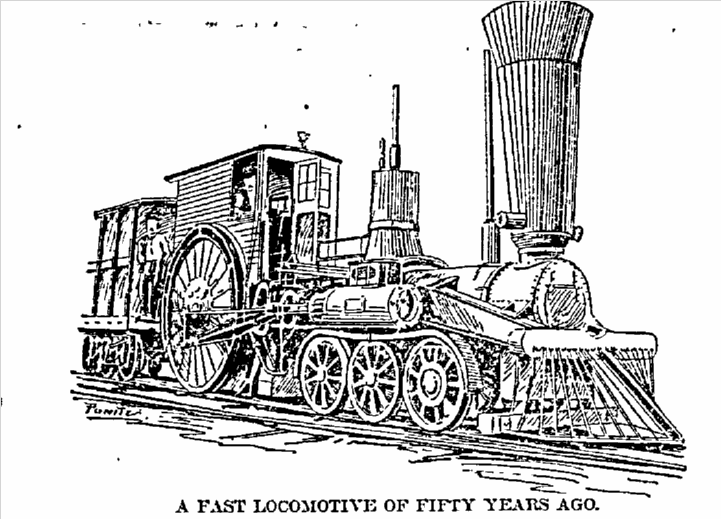
Our nation’s great westward expansion took off, and trains became the favored mode of transportation until automobiles and air travel took over. Reading old newspaper articles to explore the history of train travel is a good way to better understand our ancestors’ lives and the times they lived in.
Steam Powers the Way
Early trains were powered by steam, but it may surprise you to learn that steam power was not a 19th Century invention. English inventor Thomas Savery (c.1650-1715) is given the credit for inventing steam power for transportation. He didn’t work on steam-powered trains, but this 1848 Connecticut newspaper article notes he did develop a steam engine for a rowing ship.
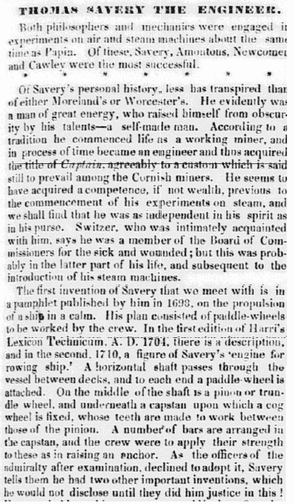
Although Savery received his steam engine patent in 1698, the first steam-powered engine didn’t arrive in the American Colonies until 1752 or 1753. Evidence of such a machine can be found in this 1753 Massachusetts newspaper article reporting that the Town of Charlestown was:
“so kind as to bring over their fine Water-Engine, which was of great Service in suppressing and preventing the Progress of the Fire.”

A screw-driven steamboat was invented around 1802 by John Stevens. A Wikipedia article mentions he created a steam carriage around 1826 that ran on a track, but he was not the only one working on the concept.
There are several early newspaper reports of inventors working on steam carriages, including this 1822 New Jersey newspaper article about a petition for a steam carriage being presented on behalf of Isaac Baker, of Ohio.

The illustration below, from an 1826 Massachusetts newspaper, shows a 12-horsepower “loco-motive engine” used by the Helton Railroad in England.

Early Train & Railroad Companies
If you’ve played that famous board game “Monopoly,” you can surely guess the first railroad thought to have provided regularly-scheduled service.
Yes, it was the Baltimore and Ohio Railroad (B&O), chartered on 28 February 1827, to provide service from Baltimore, Maryland, to the Ohio River. It was capitalized with 15,000 shares at $100 each ($1,500,000), what must have seemed like a tremendous fortune at that time.
Perhaps your ancestors traveled on the great B&O, credited to have been the first U.S. company to offer scheduled passenger and freight service?
However, B&O was not the first charted train company. A search of GenealogyBank’s historical newspaper archives finds mention of other train companies. This 1825 Pennsylvania newspaper article reports a petition to incorporate and provide service from Wilkesbarre, Pennsylvania, “to the nearest point on the Delaware.”
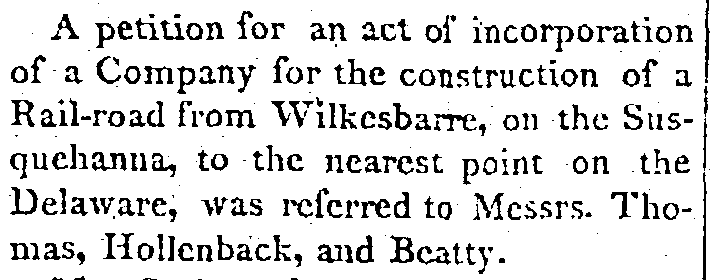
This advertisement was published in an 1856 South Carolina newspaper, showing the Virginia Springs Central Railroad’s announcement that its opening line will travel 56 miles. Until the rail line is completed, the company’s stage coaches will continue to operate at fares ranging from $10 to $13.
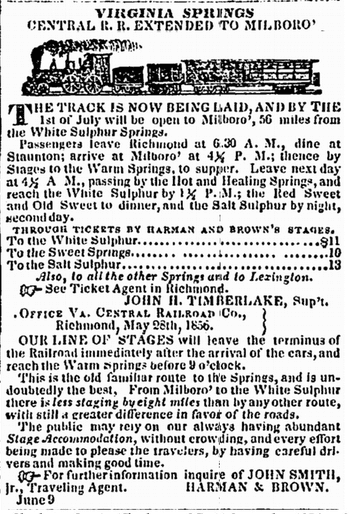
We can all imagine the excitement generated by the completion of the Transcontinental Railroad on 10 May 1869 at Promontory Summit, in Utah Territory!
To commemorate the final joining, the railroad placed a golden spike and a silver railroad tie. This article from an 1869 New York newspaper reports that that the last spike would be engraved as follows:
“The last spike. The Pacific Railroad—ground broke January 8, 1863, completed May–, 1869. May God continue the unity of our country as this railroad unites the two great oceans of the world.”
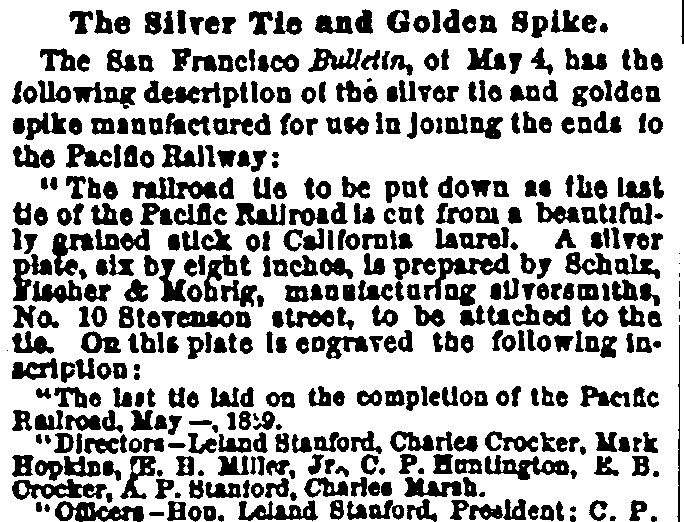
There were many other train “firsts,” such as this article from an 1898 Minnesota newspaper commemorating the first Minneapolis Locomotive crossing the first railroad bridge across the Mississippi River “at this point.”
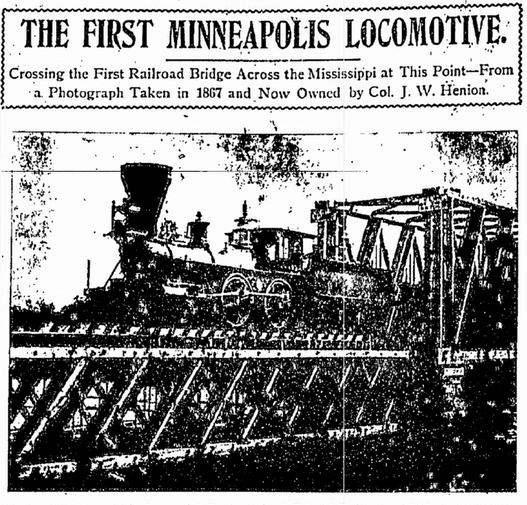
Railroad Family History for Kids (and Adults)
The children of today may never know the joy of train travel, except as a novelty. To connect your children with this important part of American history, search the newspaper archives to see if any of their ancestors were connected with the railroad industry—that may spark their interest.
In addition to their surname, be sure to search for your railroad ancestors by their job title, such as conductor or switchman. Also search for railway pension records (which are in a separate system from Social Security).
Here is an example of an old newspaper article that may show your ancestors in the context of railroad travel. This 1857 Pennsylvania newspaper wedding announcement notes that the marriage of William C. Pitman and Miss F.A. Fuller occurred on a moving train that exceeded 40 miles per hour!
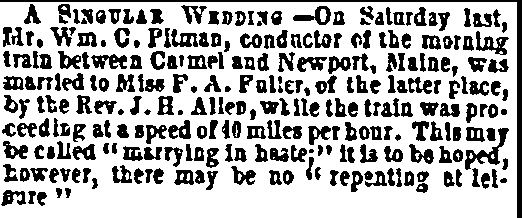
This is just the tip of the iceberg for conducting research on how our ancestors were connected to trains, either by occupation or their desire to travel.
Websites and Documents of Interest
Cyndi’s List: Railroads >> Records: Administrative, Employment and Pensions
U.S. Railroad Retirement Board
“I’ve Been Working on the Railroad”
The original title of “I’ve Been Working on the Railroad” was “The Levee Song,” published in 1894 in a book of songs published by Princeton University titled Carmina Princetonia. If you search GenealogyBank you can locate several references to this famous song, including this one.

Have fun filling in the lives of your ancestors and the times they lived in with railroad and train stories. You never know what you’ll discover about your family history!

My late husband’s grandfather was a fireman on the Reading RR out of Philadephia, Pa. We have been trying to find his death date and reason for death. Word of mouth has it that he was killed on a train somehow. His name is John Kerry and he was born about 1880 – 1883, according to several US censuses, in either Norway or at sea. I have assumed that his father must have been a seaman on a ship that went between Great Britain and Norway, since Kerry is very definitely an Irish name. Can you give me any leads to follow?
Are there newspaper articles available about my family history, my father Thomas Lazarus and my mother Sylvia Vicstein? In the 1880 census in Texas, Wayne county, Penn,, my maternal great grandmother was listed as “Annie” Abrams, along with her husband Nathan Abrams, but from other sources, as in my grandmother Florence’s marriage certificate of 6/28/1903, the correct name should be Rachel. I am unable to solve this puzzle.
Sincerely,
Amy Wilson (born Amelia Lazarus 3/4/1937
“Rachel,” as shown in my grandmother Flora’s marriage certificate of June 28, 1903.
Jane,
I’m not certain, but you might try the U.S. Retirement Board Website at https://www.usa.gov/federal-agencies/railroad-retirement-board to see if they have leads on Mr. Kerry’s death.
Mary